The Impact of Social Media l Assignment
VerifiedAdded on 2022/09/14
|13
|3815
|12
Assignment
AI Summary
Contribute Materials
Your contribution can guide someone’s learning journey. Share your
documents today.
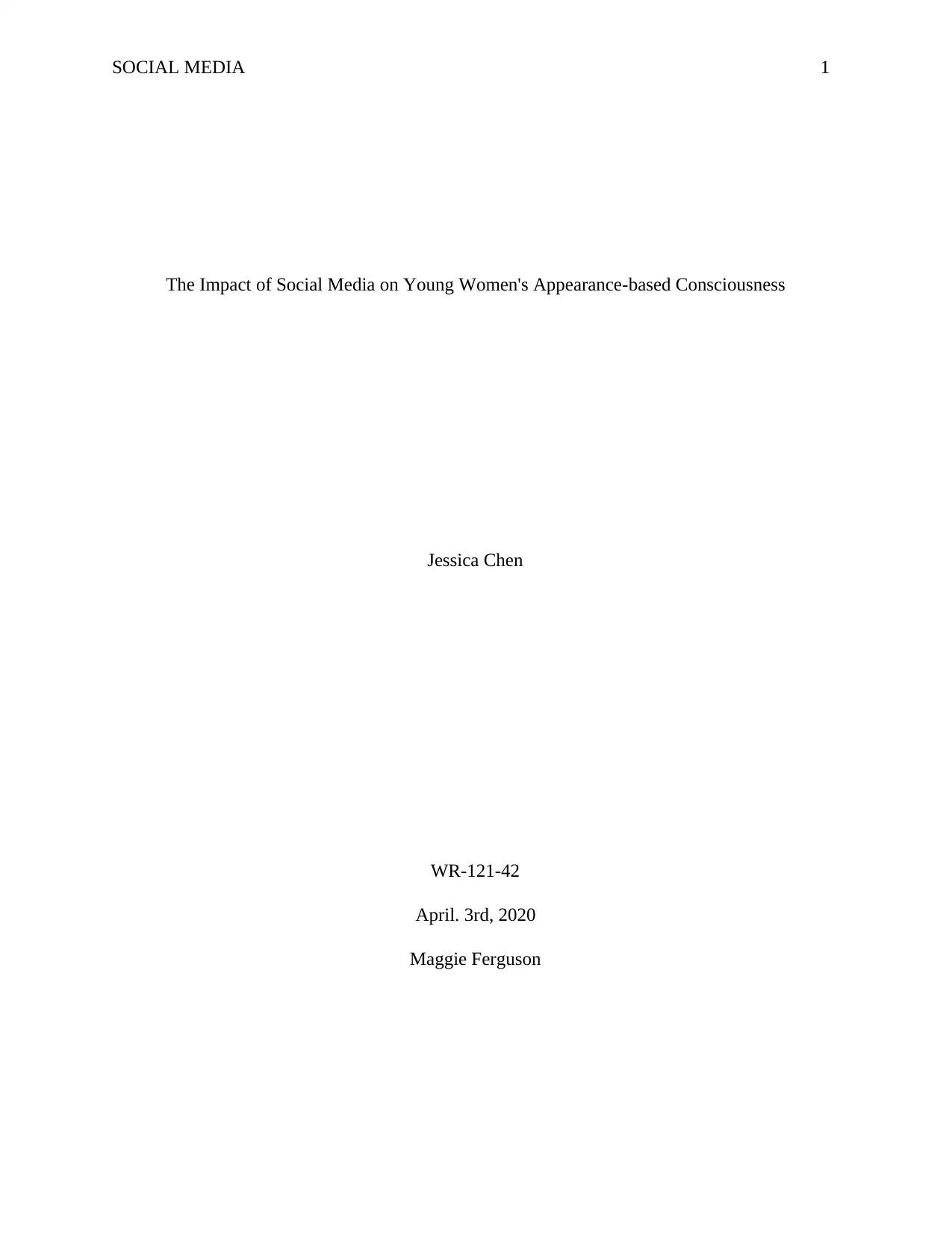
SOCIAL MEDIA 1
The Impact of Social Media on Young Women's Appearance-based Consciousness
Jessica Chen
WR-121-42
April. 3rd, 2020
Maggie Ferguson
The Impact of Social Media on Young Women's Appearance-based Consciousness
Jessica Chen
WR-121-42
April. 3rd, 2020
Maggie Ferguson
Secure Best Marks with AI Grader
Need help grading? Try our AI Grader for instant feedback on your assignments.
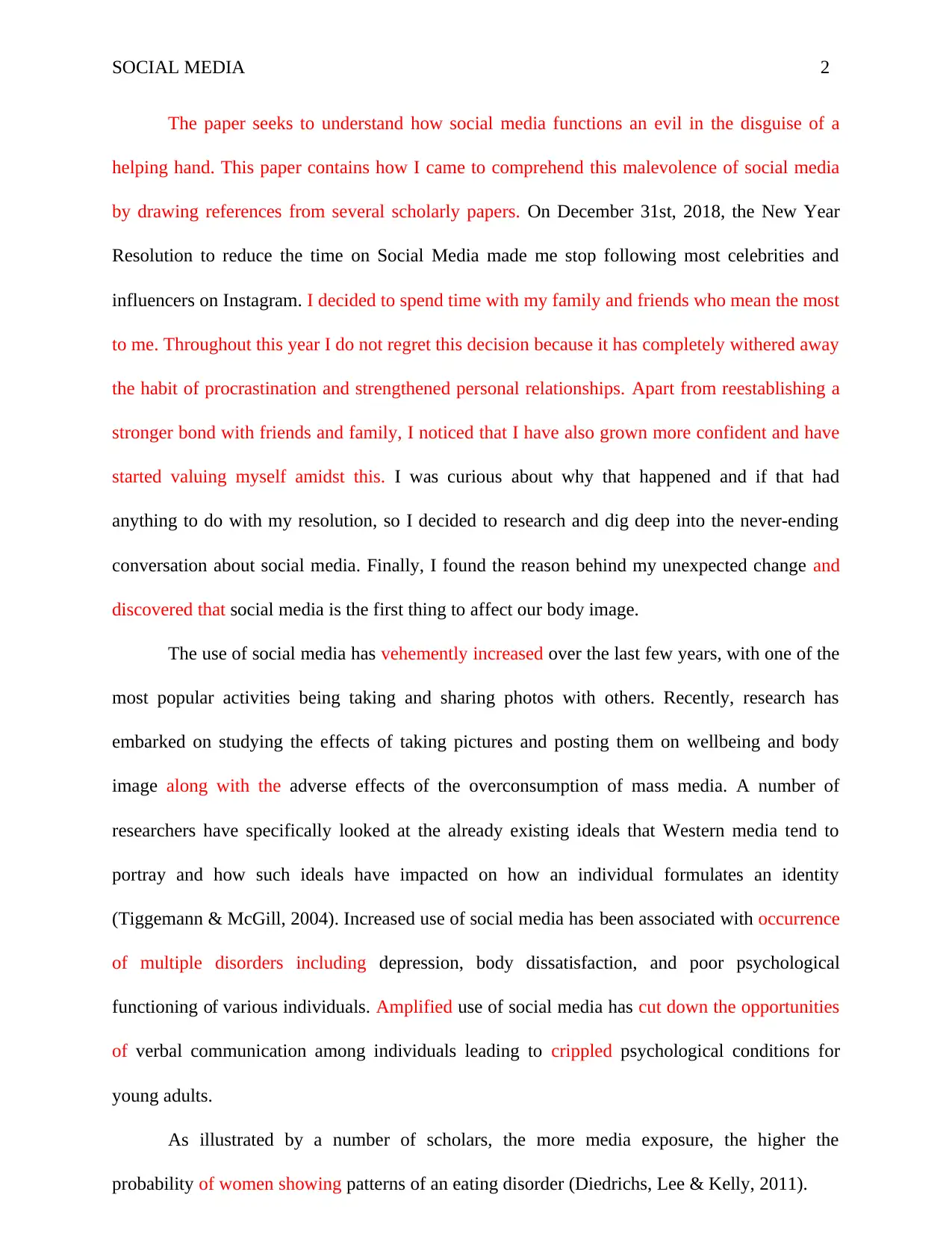
2SOCIAL MEDIA
The paper seeks to understand how social media functions an evil in the disguise of a
helping hand. This paper contains how I came to comprehend this malevolence of social media
by drawing references from several scholarly papers. On December 31st, 2018, the New Year
Resolution to reduce the time on Social Media made me stop following most celebrities and
influencers on Instagram. I decided to spend time with my family and friends who mean the most
to me. Throughout this year I do not regret this decision because it has completely withered away
the habit of procrastination and strengthened personal relationships. Apart from reestablishing a
stronger bond with friends and family, I noticed that I have also grown more confident and have
started valuing myself amidst this. I was curious about why that happened and if that had
anything to do with my resolution, so I decided to research and dig deep into the never-ending
conversation about social media. Finally, I found the reason behind my unexpected change and
discovered that social media is the first thing to affect our body image.
The use of social media has vehemently increased over the last few years, with one of the
most popular activities being taking and sharing photos with others. Recently, research has
embarked on studying the effects of taking pictures and posting them on wellbeing and body
image along with the adverse effects of the overconsumption of mass media. A number of
researchers have specifically looked at the already existing ideals that Western media tend to
portray and how such ideals have impacted on how an individual formulates an identity
(Tiggemann & McGill, 2004). Increased use of social media has been associated with occurrence
of multiple disorders including depression, body dissatisfaction, and poor psychological
functioning of various individuals. Amplified use of social media has cut down the opportunities
of verbal communication among individuals leading to crippled psychological conditions for
young adults.
As illustrated by a number of scholars, the more media exposure, the higher the
probability of women showing patterns of an eating disorder (Diedrichs, Lee & Kelly, 2011).
The paper seeks to understand how social media functions an evil in the disguise of a
helping hand. This paper contains how I came to comprehend this malevolence of social media
by drawing references from several scholarly papers. On December 31st, 2018, the New Year
Resolution to reduce the time on Social Media made me stop following most celebrities and
influencers on Instagram. I decided to spend time with my family and friends who mean the most
to me. Throughout this year I do not regret this decision because it has completely withered away
the habit of procrastination and strengthened personal relationships. Apart from reestablishing a
stronger bond with friends and family, I noticed that I have also grown more confident and have
started valuing myself amidst this. I was curious about why that happened and if that had
anything to do with my resolution, so I decided to research and dig deep into the never-ending
conversation about social media. Finally, I found the reason behind my unexpected change and
discovered that social media is the first thing to affect our body image.
The use of social media has vehemently increased over the last few years, with one of the
most popular activities being taking and sharing photos with others. Recently, research has
embarked on studying the effects of taking pictures and posting them on wellbeing and body
image along with the adverse effects of the overconsumption of mass media. A number of
researchers have specifically looked at the already existing ideals that Western media tend to
portray and how such ideals have impacted on how an individual formulates an identity
(Tiggemann & McGill, 2004). Increased use of social media has been associated with occurrence
of multiple disorders including depression, body dissatisfaction, and poor psychological
functioning of various individuals. Amplified use of social media has cut down the opportunities
of verbal communication among individuals leading to crippled psychological conditions for
young adults.
As illustrated by a number of scholars, the more media exposure, the higher the
probability of women showing patterns of an eating disorder (Diedrichs, Lee & Kelly, 2011).
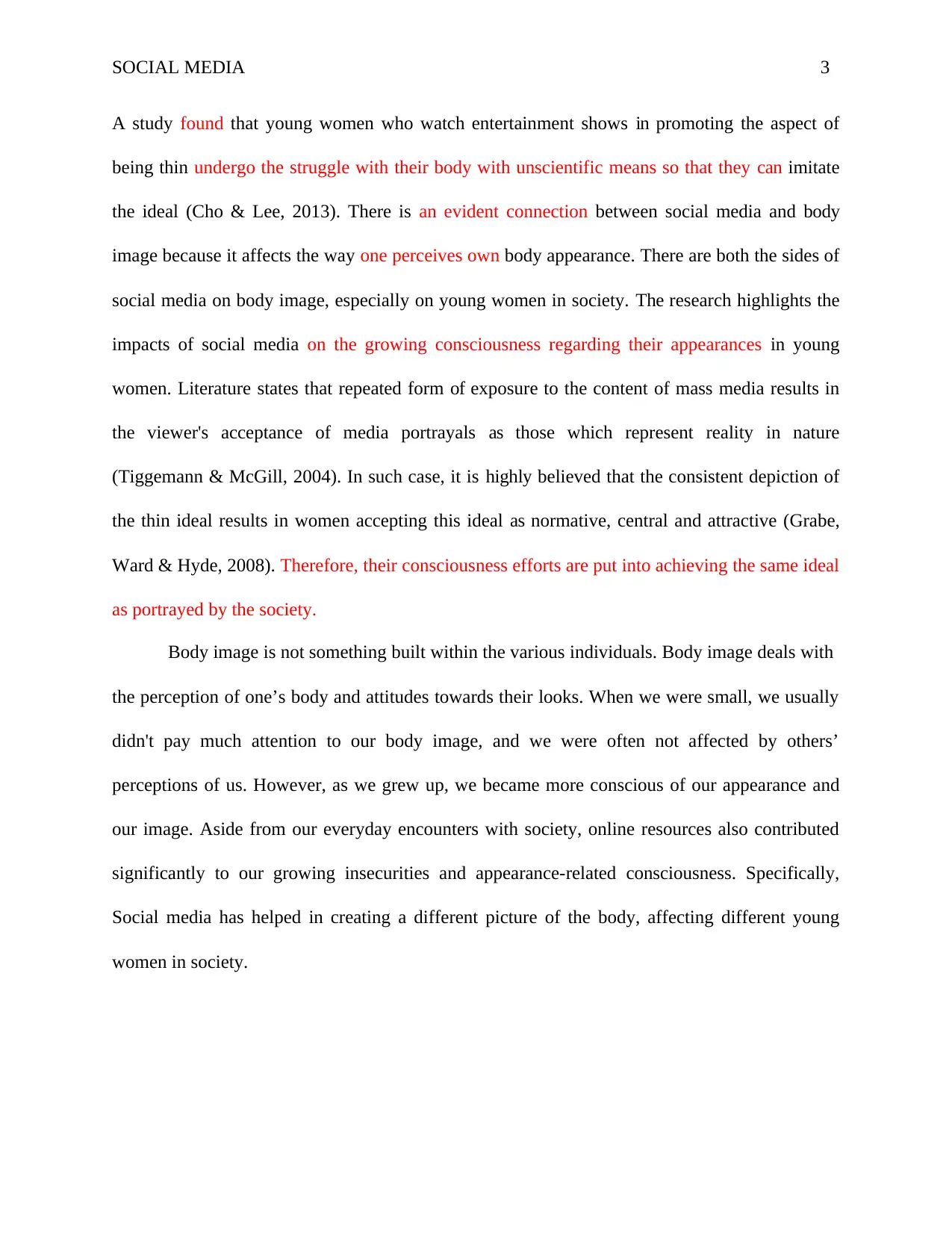
3SOCIAL MEDIA
A study found that young women who watch entertainment shows in promoting the aspect of
being thin undergo the struggle with their body with unscientific means so that they can imitate
the ideal (Cho & Lee, 2013). There is an evident connection between social media and body
image because it affects the way one perceives own body appearance. There are both the sides of
social media on body image, especially on young women in society. The research highlights the
impacts of social media on the growing consciousness regarding their appearances in young
women. Literature states that repeated form of exposure to the content of mass media results in
the viewer's acceptance of media portrayals as those which represent reality in nature
(Tiggemann & McGill, 2004). In such case, it is highly believed that the consistent depiction of
the thin ideal results in women accepting this ideal as normative, central and attractive (Grabe,
Ward & Hyde, 2008). Therefore, their consciousness efforts are put into achieving the same ideal
as portrayed by the society.
Body image is not something built within the various individuals. Body image deals with
the perception of one’s body and attitudes towards their looks. When we were small, we usually
didn't pay much attention to our body image, and we were often not affected by others’
perceptions of us. However, as we grew up, we became more conscious of our appearance and
our image. Aside from our everyday encounters with society, online resources also contributed
significantly to our growing insecurities and appearance-related consciousness. Specifically,
Social media has helped in creating a different picture of the body, affecting different young
women in society.
A study found that young women who watch entertainment shows in promoting the aspect of
being thin undergo the struggle with their body with unscientific means so that they can imitate
the ideal (Cho & Lee, 2013). There is an evident connection between social media and body
image because it affects the way one perceives own body appearance. There are both the sides of
social media on body image, especially on young women in society. The research highlights the
impacts of social media on the growing consciousness regarding their appearances in young
women. Literature states that repeated form of exposure to the content of mass media results in
the viewer's acceptance of media portrayals as those which represent reality in nature
(Tiggemann & McGill, 2004). In such case, it is highly believed that the consistent depiction of
the thin ideal results in women accepting this ideal as normative, central and attractive (Grabe,
Ward & Hyde, 2008). Therefore, their consciousness efforts are put into achieving the same ideal
as portrayed by the society.
Body image is not something built within the various individuals. Body image deals with
the perception of one’s body and attitudes towards their looks. When we were small, we usually
didn't pay much attention to our body image, and we were often not affected by others’
perceptions of us. However, as we grew up, we became more conscious of our appearance and
our image. Aside from our everyday encounters with society, online resources also contributed
significantly to our growing insecurities and appearance-related consciousness. Specifically,
Social media has helped in creating a different picture of the body, affecting different young
women in society.
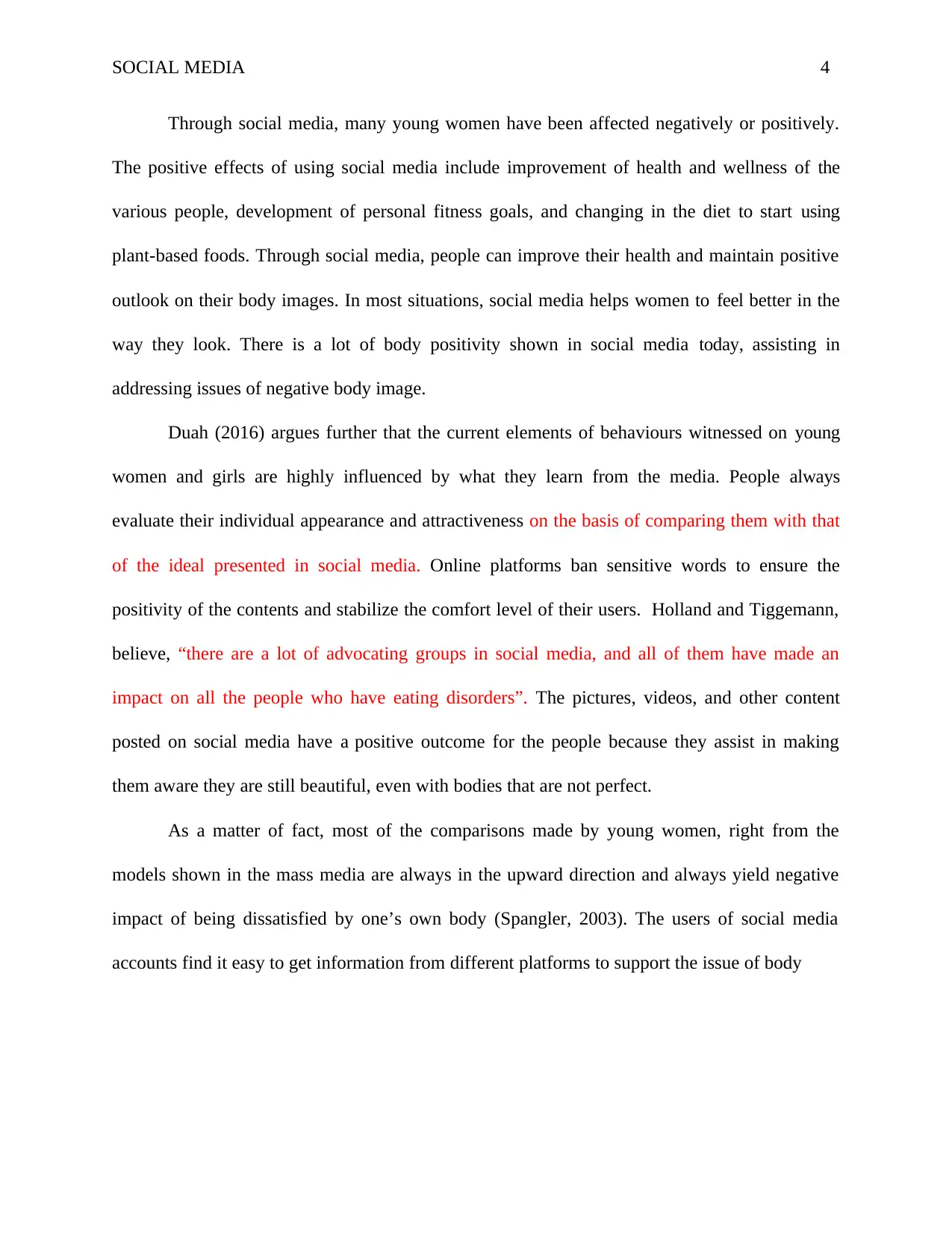
4SOCIAL MEDIA
Through social media, many young women have been affected negatively or positively.
The positive effects of using social media include improvement of health and wellness of the
various people, development of personal fitness goals, and changing in the diet to start using
plant-based foods. Through social media, people can improve their health and maintain positive
outlook on their body images. In most situations, social media helps women to feel better in the
way they look. There is a lot of body positivity shown in social media today, assisting in
addressing issues of negative body image.
Duah (2016) argues further that the current elements of behaviours witnessed on young
women and girls are highly influenced by what they learn from the media. People always
evaluate their individual appearance and attractiveness on the basis of comparing them with that
of the ideal presented in social media. Online platforms ban sensitive words to ensure the
positivity of the contents and stabilize the comfort level of their users. Holland and Tiggemann,
believe, “there are a lot of advocating groups in social media, and all of them have made an
impact on all the people who have eating disorders”. The pictures, videos, and other content
posted on social media have a positive outcome for the people because they assist in making
them aware they are still beautiful, even with bodies that are not perfect.
As a matter of fact, most of the comparisons made by young women, right from the
models shown in the mass media are always in the upward direction and always yield negative
impact of being dissatisfied by one’s own body (Spangler, 2003). The users of social media
accounts find it easy to get information from different platforms to support the issue of body
Through social media, many young women have been affected negatively or positively.
The positive effects of using social media include improvement of health and wellness of the
various people, development of personal fitness goals, and changing in the diet to start using
plant-based foods. Through social media, people can improve their health and maintain positive
outlook on their body images. In most situations, social media helps women to feel better in the
way they look. There is a lot of body positivity shown in social media today, assisting in
addressing issues of negative body image.
Duah (2016) argues further that the current elements of behaviours witnessed on young
women and girls are highly influenced by what they learn from the media. People always
evaluate their individual appearance and attractiveness on the basis of comparing them with that
of the ideal presented in social media. Online platforms ban sensitive words to ensure the
positivity of the contents and stabilize the comfort level of their users. Holland and Tiggemann,
believe, “there are a lot of advocating groups in social media, and all of them have made an
impact on all the people who have eating disorders”. The pictures, videos, and other content
posted on social media have a positive outcome for the people because they assist in making
them aware they are still beautiful, even with bodies that are not perfect.
As a matter of fact, most of the comparisons made by young women, right from the
models shown in the mass media are always in the upward direction and always yield negative
impact of being dissatisfied by one’s own body (Spangler, 2003). The users of social media
accounts find it easy to get information from different platforms to support the issue of body
Secure Best Marks with AI Grader
Need help grading? Try our AI Grader for instant feedback on your assignments.
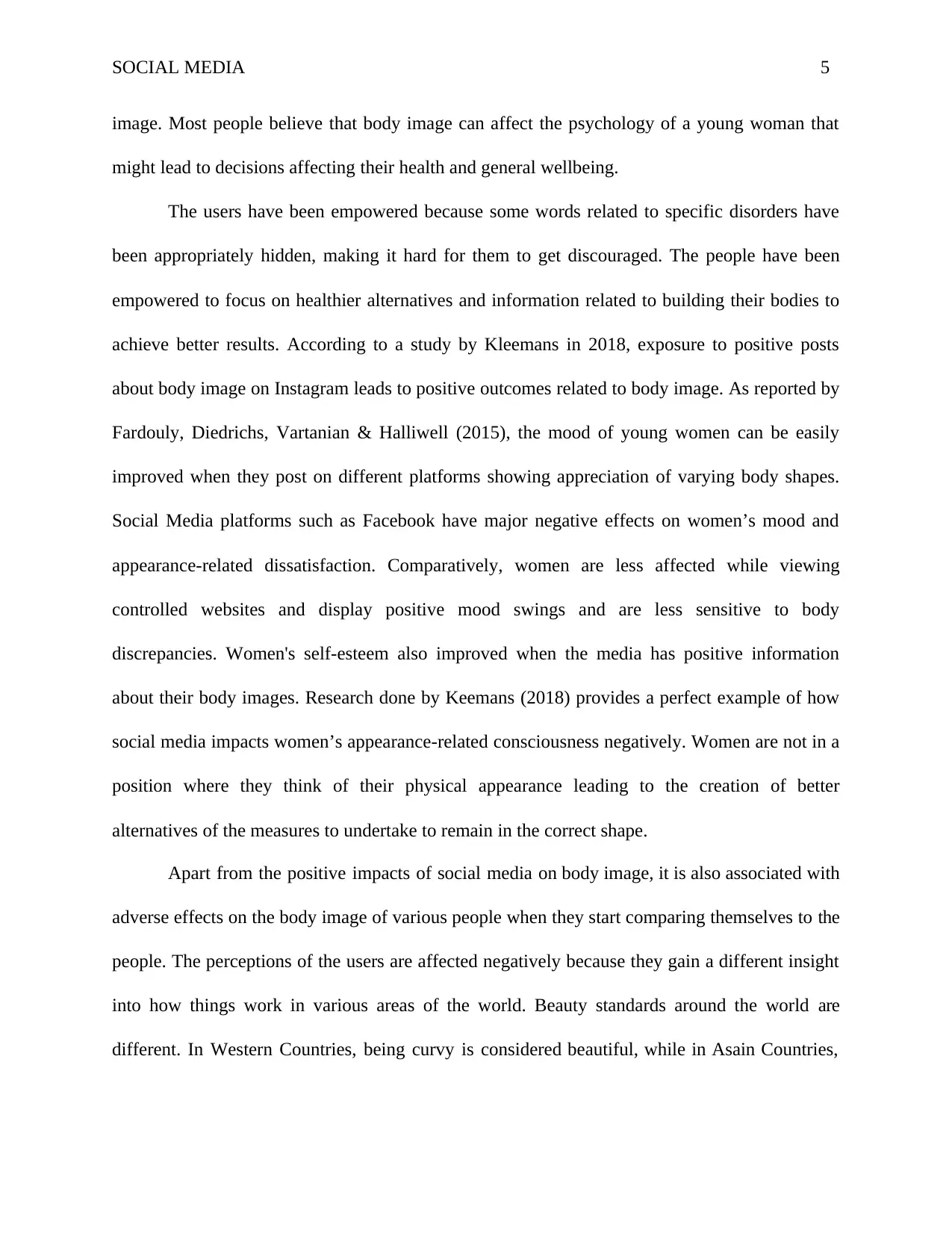
5SOCIAL MEDIA
image. Most people believe that body image can affect the psychology of a young woman that
might lead to decisions affecting their health and general wellbeing.
The users have been empowered because some words related to specific disorders have
been appropriately hidden, making it hard for them to get discouraged. The people have been
empowered to focus on healthier alternatives and information related to building their bodies to
achieve better results. According to a study by Kleemans in 2018, exposure to positive posts
about body image on Instagram leads to positive outcomes related to body image. As reported by
Fardouly, Diedrichs, Vartanian & Halliwell (2015), the mood of young women can be easily
improved when they post on different platforms showing appreciation of varying body shapes.
Social Media platforms such as Facebook have major negative effects on women’s mood and
appearance-related dissatisfaction. Comparatively, women are less affected while viewing
controlled websites and display positive mood swings and are less sensitive to body
discrepancies. Women's self-esteem also improved when the media has positive information
about their body images. Research done by Keemans (2018) provides a perfect example of how
social media impacts women’s appearance-related consciousness negatively. Women are not in a
position where they think of their physical appearance leading to the creation of better
alternatives of the measures to undertake to remain in the correct shape.
Apart from the positive impacts of social media on body image, it is also associated with
adverse effects on the body image of various people when they start comparing themselves to the
people. The perceptions of the users are affected negatively because they gain a different insight
into how things work in various areas of the world. Beauty standards around the world are
different. In Western Countries, being curvy is considered beautiful, while in Asain Countries,
image. Most people believe that body image can affect the psychology of a young woman that
might lead to decisions affecting their health and general wellbeing.
The users have been empowered because some words related to specific disorders have
been appropriately hidden, making it hard for them to get discouraged. The people have been
empowered to focus on healthier alternatives and information related to building their bodies to
achieve better results. According to a study by Kleemans in 2018, exposure to positive posts
about body image on Instagram leads to positive outcomes related to body image. As reported by
Fardouly, Diedrichs, Vartanian & Halliwell (2015), the mood of young women can be easily
improved when they post on different platforms showing appreciation of varying body shapes.
Social Media platforms such as Facebook have major negative effects on women’s mood and
appearance-related dissatisfaction. Comparatively, women are less affected while viewing
controlled websites and display positive mood swings and are less sensitive to body
discrepancies. Women's self-esteem also improved when the media has positive information
about their body images. Research done by Keemans (2018) provides a perfect example of how
social media impacts women’s appearance-related consciousness negatively. Women are not in a
position where they think of their physical appearance leading to the creation of better
alternatives of the measures to undertake to remain in the correct shape.
Apart from the positive impacts of social media on body image, it is also associated with
adverse effects on the body image of various people when they start comparing themselves to the
people. The perceptions of the users are affected negatively because they gain a different insight
into how things work in various areas of the world. Beauty standards around the world are
different. In Western Countries, being curvy is considered beautiful, while in Asain Countries,
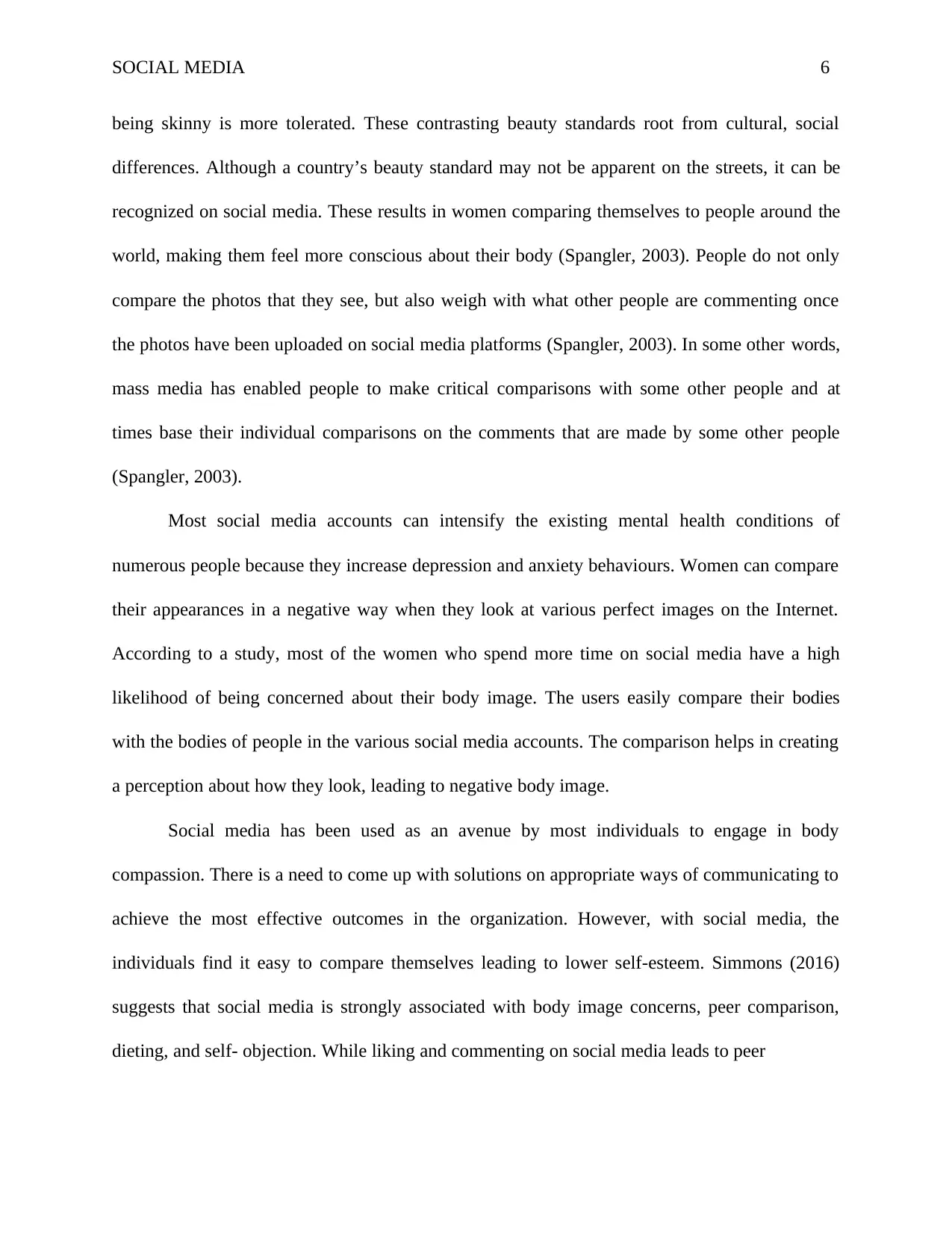
6SOCIAL MEDIA
being skinny is more tolerated. These contrasting beauty standards root from cultural, social
differences. Although a country’s beauty standard may not be apparent on the streets, it can be
recognized on social media. These results in women comparing themselves to people around the
world, making them feel more conscious about their body (Spangler, 2003). People do not only
compare the photos that they see, but also weigh with what other people are commenting once
the photos have been uploaded on social media platforms (Spangler, 2003). In some other words,
mass media has enabled people to make critical comparisons with some other people and at
times base their individual comparisons on the comments that are made by some other people
(Spangler, 2003).
Most social media accounts can intensify the existing mental health conditions of
numerous people because they increase depression and anxiety behaviours. Women can compare
their appearances in a negative way when they look at various perfect images on the Internet.
According to a study, most of the women who spend more time on social media have a high
likelihood of being concerned about their body image. The users easily compare their bodies
with the bodies of people in the various social media accounts. The comparison helps in creating
a perception about how they look, leading to negative body image.
Social media has been used as an avenue by most individuals to engage in body
compassion. There is a need to come up with solutions on appropriate ways of communicating to
achieve the most effective outcomes in the organization. However, with social media, the
individuals find it easy to compare themselves leading to lower self-esteem. Simmons (2016)
suggests that social media is strongly associated with body image concerns, peer comparison,
dieting, and self- objection. While liking and commenting on social media leads to peer
being skinny is more tolerated. These contrasting beauty standards root from cultural, social
differences. Although a country’s beauty standard may not be apparent on the streets, it can be
recognized on social media. These results in women comparing themselves to people around the
world, making them feel more conscious about their body (Spangler, 2003). People do not only
compare the photos that they see, but also weigh with what other people are commenting once
the photos have been uploaded on social media platforms (Spangler, 2003). In some other words,
mass media has enabled people to make critical comparisons with some other people and at
times base their individual comparisons on the comments that are made by some other people
(Spangler, 2003).
Most social media accounts can intensify the existing mental health conditions of
numerous people because they increase depression and anxiety behaviours. Women can compare
their appearances in a negative way when they look at various perfect images on the Internet.
According to a study, most of the women who spend more time on social media have a high
likelihood of being concerned about their body image. The users easily compare their bodies
with the bodies of people in the various social media accounts. The comparison helps in creating
a perception about how they look, leading to negative body image.
Social media has been used as an avenue by most individuals to engage in body
compassion. There is a need to come up with solutions on appropriate ways of communicating to
achieve the most effective outcomes in the organization. However, with social media, the
individuals find it easy to compare themselves leading to lower self-esteem. Simmons (2016)
suggests that social media is strongly associated with body image concerns, peer comparison,
dieting, and self- objection. While liking and commenting on social media leads to peer
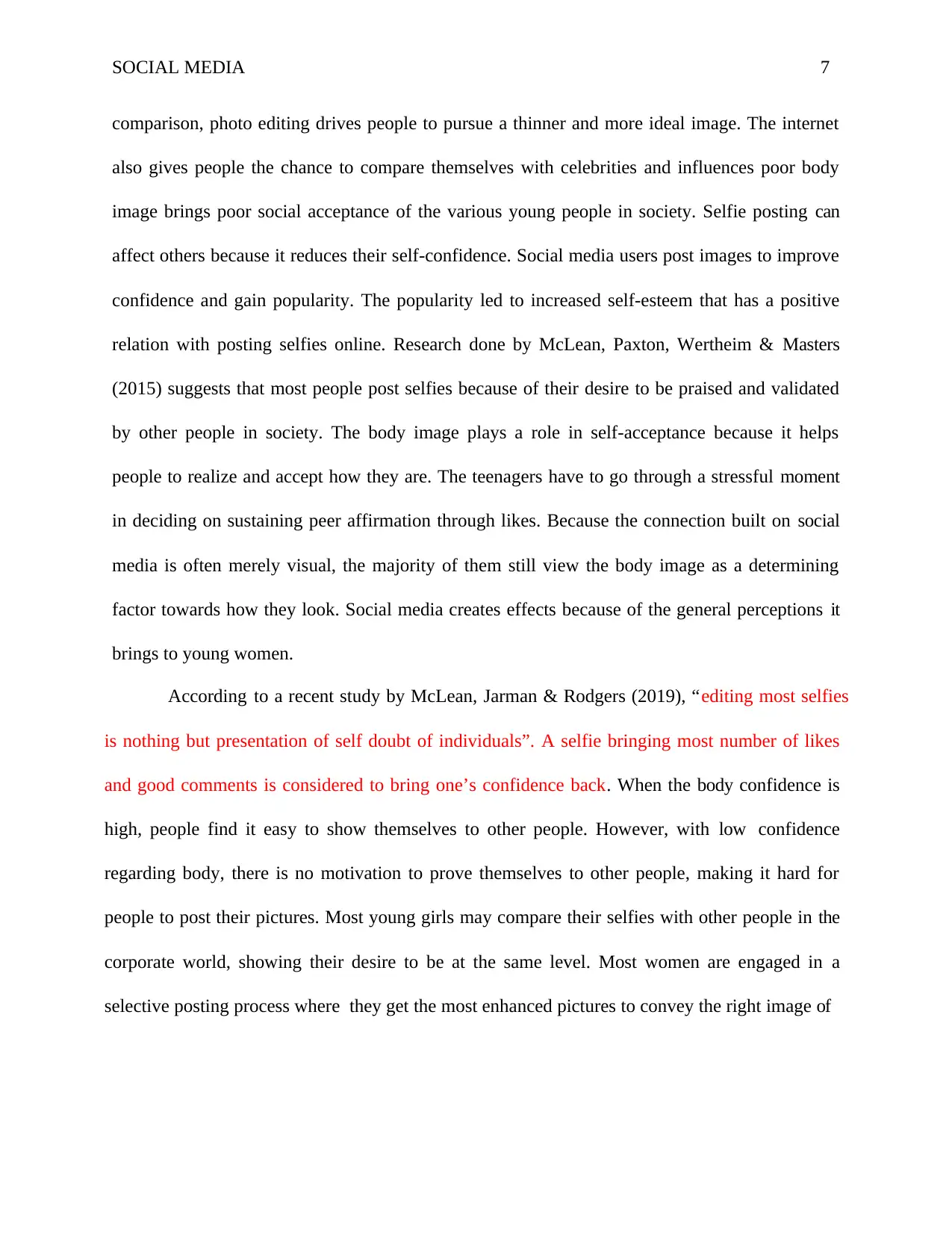
7SOCIAL MEDIA
comparison, photo editing drives people to pursue a thinner and more ideal image. The internet
also gives people the chance to compare themselves with celebrities and influences poor body
image brings poor social acceptance of the various young people in society. Selfie posting can
affect others because it reduces their self-confidence. Social media users post images to improve
confidence and gain popularity. The popularity led to increased self-esteem that has a positive
relation with posting selfies online. Research done by McLean, Paxton, Wertheim & Masters
(2015) suggests that most people post selfies because of their desire to be praised and validated
by other people in society. The body image plays a role in self-acceptance because it helps
people to realize and accept how they are. The teenagers have to go through a stressful moment
in deciding on sustaining peer affirmation through likes. Because the connection built on social
media is often merely visual, the majority of them still view the body image as a determining
factor towards how they look. Social media creates effects because of the general perceptions it
brings to young women.
According to a recent study by McLean, Jarman & Rodgers (2019), “editing most selfies
is nothing but presentation of self doubt of individuals”. A selfie bringing most number of likes
and good comments is considered to bring one’s confidence back. When the body confidence is
high, people find it easy to show themselves to other people. However, with low confidence
regarding body, there is no motivation to prove themselves to other people, making it hard for
people to post their pictures. Most young girls may compare their selfies with other people in the
corporate world, showing their desire to be at the same level. Most women are engaged in a
selective posting process where they get the most enhanced pictures to convey the right image of
comparison, photo editing drives people to pursue a thinner and more ideal image. The internet
also gives people the chance to compare themselves with celebrities and influences poor body
image brings poor social acceptance of the various young people in society. Selfie posting can
affect others because it reduces their self-confidence. Social media users post images to improve
confidence and gain popularity. The popularity led to increased self-esteem that has a positive
relation with posting selfies online. Research done by McLean, Paxton, Wertheim & Masters
(2015) suggests that most people post selfies because of their desire to be praised and validated
by other people in society. The body image plays a role in self-acceptance because it helps
people to realize and accept how they are. The teenagers have to go through a stressful moment
in deciding on sustaining peer affirmation through likes. Because the connection built on social
media is often merely visual, the majority of them still view the body image as a determining
factor towards how they look. Social media creates effects because of the general perceptions it
brings to young women.
According to a recent study by McLean, Jarman & Rodgers (2019), “editing most selfies
is nothing but presentation of self doubt of individuals”. A selfie bringing most number of likes
and good comments is considered to bring one’s confidence back. When the body confidence is
high, people find it easy to show themselves to other people. However, with low confidence
regarding body, there is no motivation to prove themselves to other people, making it hard for
people to post their pictures. Most young girls may compare their selfies with other people in the
corporate world, showing their desire to be at the same level. Most women are engaged in a
selective posting process where they get the most enhanced pictures to convey the right image of
Paraphrase This Document
Need a fresh take? Get an instant paraphrase of this document with our AI Paraphraser
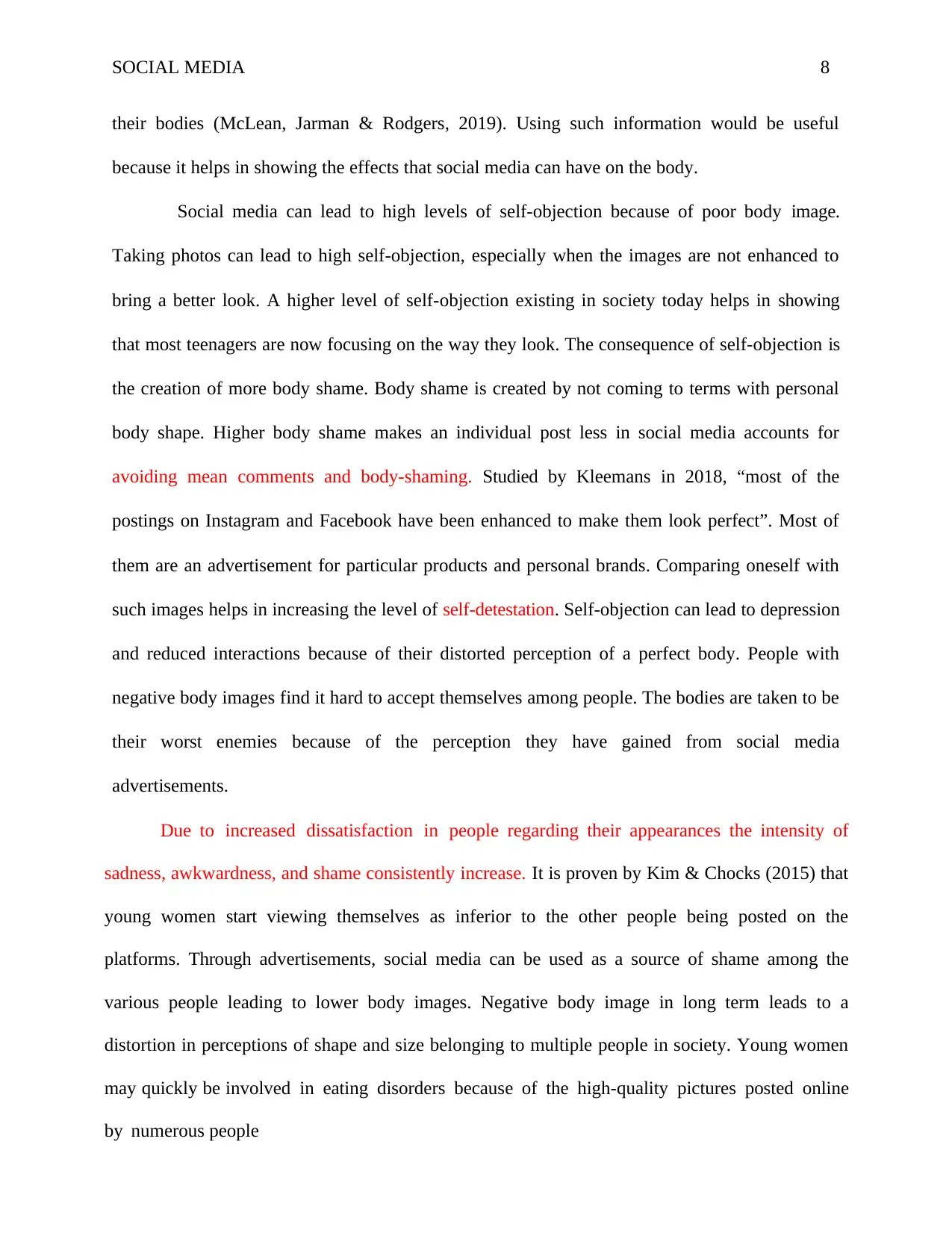
8SOCIAL MEDIA
their bodies (McLean, Jarman & Rodgers, 2019). Using such information would be useful
because it helps in showing the effects that social media can have on the body.
Social media can lead to high levels of self-objection because of poor body image.
Taking photos can lead to high self-objection, especially when the images are not enhanced to
bring a better look. A higher level of self-objection existing in society today helps in showing
that most teenagers are now focusing on the way they look. The consequence of self-objection is
the creation of more body shame. Body shame is created by not coming to terms with personal
body shape. Higher body shame makes an individual post less in social media accounts for
avoiding mean comments and body-shaming. Studied by Kleemans in 2018, “most of the
postings on Instagram and Facebook have been enhanced to make them look perfect”. Most of
them are an advertisement for particular products and personal brands. Comparing oneself with
such images helps in increasing the level of self-detestation. Self-objection can lead to depression
and reduced interactions because of their distorted perception of a perfect body. People with
negative body images find it hard to accept themselves among people. The bodies are taken to be
their worst enemies because of the perception they have gained from social media
advertisements.
Due to increased dissatisfaction in people regarding their appearances the intensity of
sadness, awkwardness, and shame consistently increase. It is proven by Kim & Chocks (2015) that
young women start viewing themselves as inferior to the other people being posted on the
platforms. Through advertisements, social media can be used as a source of shame among the
various people leading to lower body images. Negative body image in long term leads to a
distortion in perceptions of shape and size belonging to multiple people in society. Young women
may quickly be involved in eating disorders because of the high-quality pictures posted online
by numerous people
their bodies (McLean, Jarman & Rodgers, 2019). Using such information would be useful
because it helps in showing the effects that social media can have on the body.
Social media can lead to high levels of self-objection because of poor body image.
Taking photos can lead to high self-objection, especially when the images are not enhanced to
bring a better look. A higher level of self-objection existing in society today helps in showing
that most teenagers are now focusing on the way they look. The consequence of self-objection is
the creation of more body shame. Body shame is created by not coming to terms with personal
body shape. Higher body shame makes an individual post less in social media accounts for
avoiding mean comments and body-shaming. Studied by Kleemans in 2018, “most of the
postings on Instagram and Facebook have been enhanced to make them look perfect”. Most of
them are an advertisement for particular products and personal brands. Comparing oneself with
such images helps in increasing the level of self-detestation. Self-objection can lead to depression
and reduced interactions because of their distorted perception of a perfect body. People with
negative body images find it hard to accept themselves among people. The bodies are taken to be
their worst enemies because of the perception they have gained from social media
advertisements.
Due to increased dissatisfaction in people regarding their appearances the intensity of
sadness, awkwardness, and shame consistently increase. It is proven by Kim & Chocks (2015) that
young women start viewing themselves as inferior to the other people being posted on the
platforms. Through advertisements, social media can be used as a source of shame among the
various people leading to lower body images. Negative body image in long term leads to a
distortion in perceptions of shape and size belonging to multiple people in society. Young women
may quickly be involved in eating disorders because of the high-quality pictures posted online
by numerous people
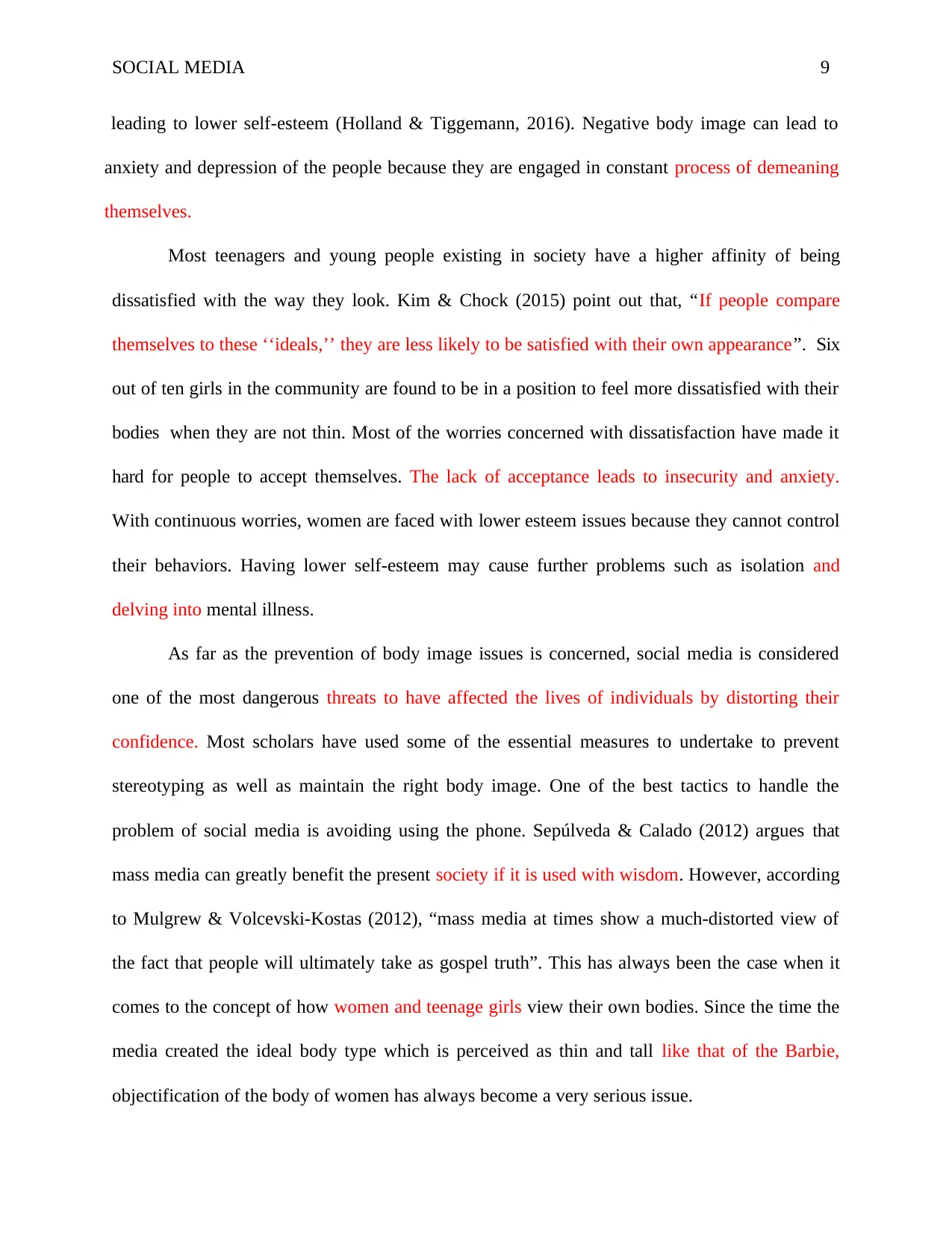
9SOCIAL MEDIA
leading to lower self-esteem (Holland & Tiggemann, 2016). Negative body image can lead to
anxiety and depression of the people because they are engaged in constant process of demeaning
themselves.
Most teenagers and young people existing in society have a higher affinity of being
dissatisfied with the way they look. Kim & Chock (2015) point out that, “If people compare
themselves to these ‘‘ideals,’’ they are less likely to be satisfied with their own appearance”. Six
out of ten girls in the community are found to be in a position to feel more dissatisfied with their
bodies when they are not thin. Most of the worries concerned with dissatisfaction have made it
hard for people to accept themselves. The lack of acceptance leads to insecurity and anxiety.
With continuous worries, women are faced with lower esteem issues because they cannot control
their behaviors. Having lower self-esteem may cause further problems such as isolation and
delving into mental illness.
As far as the prevention of body image issues is concerned, social media is considered
one of the most dangerous threats to have affected the lives of individuals by distorting their
confidence. Most scholars have used some of the essential measures to undertake to prevent
stereotyping as well as maintain the right body image. One of the best tactics to handle the
problem of social media is avoiding using the phone. Sepúlveda & Calado (2012) argues that
mass media can greatly benefit the present society if it is used with wisdom. However, according
to Mulgrew & Volcevski-Kostas (2012), “mass media at times show a much-distorted view of
the fact that people will ultimately take as gospel truth”. This has always been the case when it
comes to the concept of how women and teenage girls view their own bodies. Since the time the
media created the ideal body type which is perceived as thin and tall like that of the Barbie,
objectification of the body of women has always become a very serious issue.
leading to lower self-esteem (Holland & Tiggemann, 2016). Negative body image can lead to
anxiety and depression of the people because they are engaged in constant process of demeaning
themselves.
Most teenagers and young people existing in society have a higher affinity of being
dissatisfied with the way they look. Kim & Chock (2015) point out that, “If people compare
themselves to these ‘‘ideals,’’ they are less likely to be satisfied with their own appearance”. Six
out of ten girls in the community are found to be in a position to feel more dissatisfied with their
bodies when they are not thin. Most of the worries concerned with dissatisfaction have made it
hard for people to accept themselves. The lack of acceptance leads to insecurity and anxiety.
With continuous worries, women are faced with lower esteem issues because they cannot control
their behaviors. Having lower self-esteem may cause further problems such as isolation and
delving into mental illness.
As far as the prevention of body image issues is concerned, social media is considered
one of the most dangerous threats to have affected the lives of individuals by distorting their
confidence. Most scholars have used some of the essential measures to undertake to prevent
stereotyping as well as maintain the right body image. One of the best tactics to handle the
problem of social media is avoiding using the phone. Sepúlveda & Calado (2012) argues that
mass media can greatly benefit the present society if it is used with wisdom. However, according
to Mulgrew & Volcevski-Kostas (2012), “mass media at times show a much-distorted view of
the fact that people will ultimately take as gospel truth”. This has always been the case when it
comes to the concept of how women and teenage girls view their own bodies. Since the time the
media created the ideal body type which is perceived as thin and tall like that of the Barbie,
objectification of the body of women has always become a very serious issue.
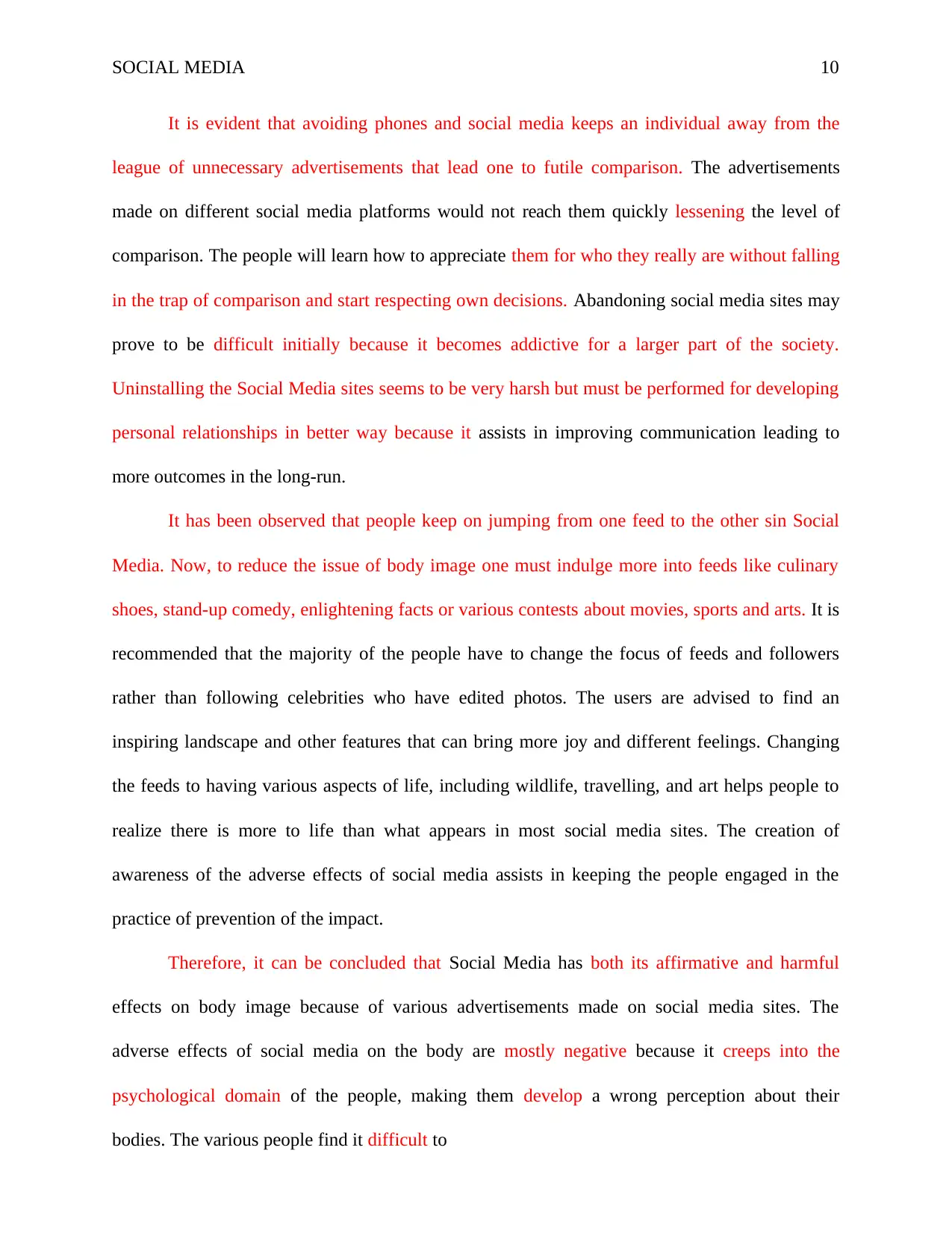
10SOCIAL MEDIA
It is evident that avoiding phones and social media keeps an individual away from the
league of unnecessary advertisements that lead one to futile comparison. The advertisements
made on different social media platforms would not reach them quickly lessening the level of
comparison. The people will learn how to appreciate them for who they really are without falling
in the trap of comparison and start respecting own decisions. Abandoning social media sites may
prove to be difficult initially because it becomes addictive for a larger part of the society.
Uninstalling the Social Media sites seems to be very harsh but must be performed for developing
personal relationships in better way because it assists in improving communication leading to
more outcomes in the long-run.
It has been observed that people keep on jumping from one feed to the other sin Social
Media. Now, to reduce the issue of body image one must indulge more into feeds like culinary
shoes, stand-up comedy, enlightening facts or various contests about movies, sports and arts. It is
recommended that the majority of the people have to change the focus of feeds and followers
rather than following celebrities who have edited photos. The users are advised to find an
inspiring landscape and other features that can bring more joy and different feelings. Changing
the feeds to having various aspects of life, including wildlife, travelling, and art helps people to
realize there is more to life than what appears in most social media sites. The creation of
awareness of the adverse effects of social media assists in keeping the people engaged in the
practice of prevention of the impact.
Therefore, it can be concluded that Social Media has both its affirmative and harmful
effects on body image because of various advertisements made on social media sites. The
adverse effects of social media on the body are mostly negative because it creeps into the
psychological domain of the people, making them develop a wrong perception about their
bodies. The various people find it difficult to
It is evident that avoiding phones and social media keeps an individual away from the
league of unnecessary advertisements that lead one to futile comparison. The advertisements
made on different social media platforms would not reach them quickly lessening the level of
comparison. The people will learn how to appreciate them for who they really are without falling
in the trap of comparison and start respecting own decisions. Abandoning social media sites may
prove to be difficult initially because it becomes addictive for a larger part of the society.
Uninstalling the Social Media sites seems to be very harsh but must be performed for developing
personal relationships in better way because it assists in improving communication leading to
more outcomes in the long-run.
It has been observed that people keep on jumping from one feed to the other sin Social
Media. Now, to reduce the issue of body image one must indulge more into feeds like culinary
shoes, stand-up comedy, enlightening facts or various contests about movies, sports and arts. It is
recommended that the majority of the people have to change the focus of feeds and followers
rather than following celebrities who have edited photos. The users are advised to find an
inspiring landscape and other features that can bring more joy and different feelings. Changing
the feeds to having various aspects of life, including wildlife, travelling, and art helps people to
realize there is more to life than what appears in most social media sites. The creation of
awareness of the adverse effects of social media assists in keeping the people engaged in the
practice of prevention of the impact.
Therefore, it can be concluded that Social Media has both its affirmative and harmful
effects on body image because of various advertisements made on social media sites. The
adverse effects of social media on the body are mostly negative because it creeps into the
psychological domain of the people, making them develop a wrong perception about their
bodies. The various people find it difficult to
Secure Best Marks with AI Grader
Need help grading? Try our AI Grader for instant feedback on your assignments.

11SOCIAL MEDIA
control the body images leading to more problems in the society. This issue of body image is
highlighted mostly by all the Social Medias. It is proven that avoiding social media sites can be
effective while developing more awareness of the threats of social media assist people in
overcoming the issues associated with their perception of their body images.
control the body images leading to more problems in the society. This issue of body image is
highlighted mostly by all the Social Medias. It is proven that avoiding social media sites can be
effective while developing more awareness of the threats of social media assist people in
overcoming the issues associated with their perception of their body images.
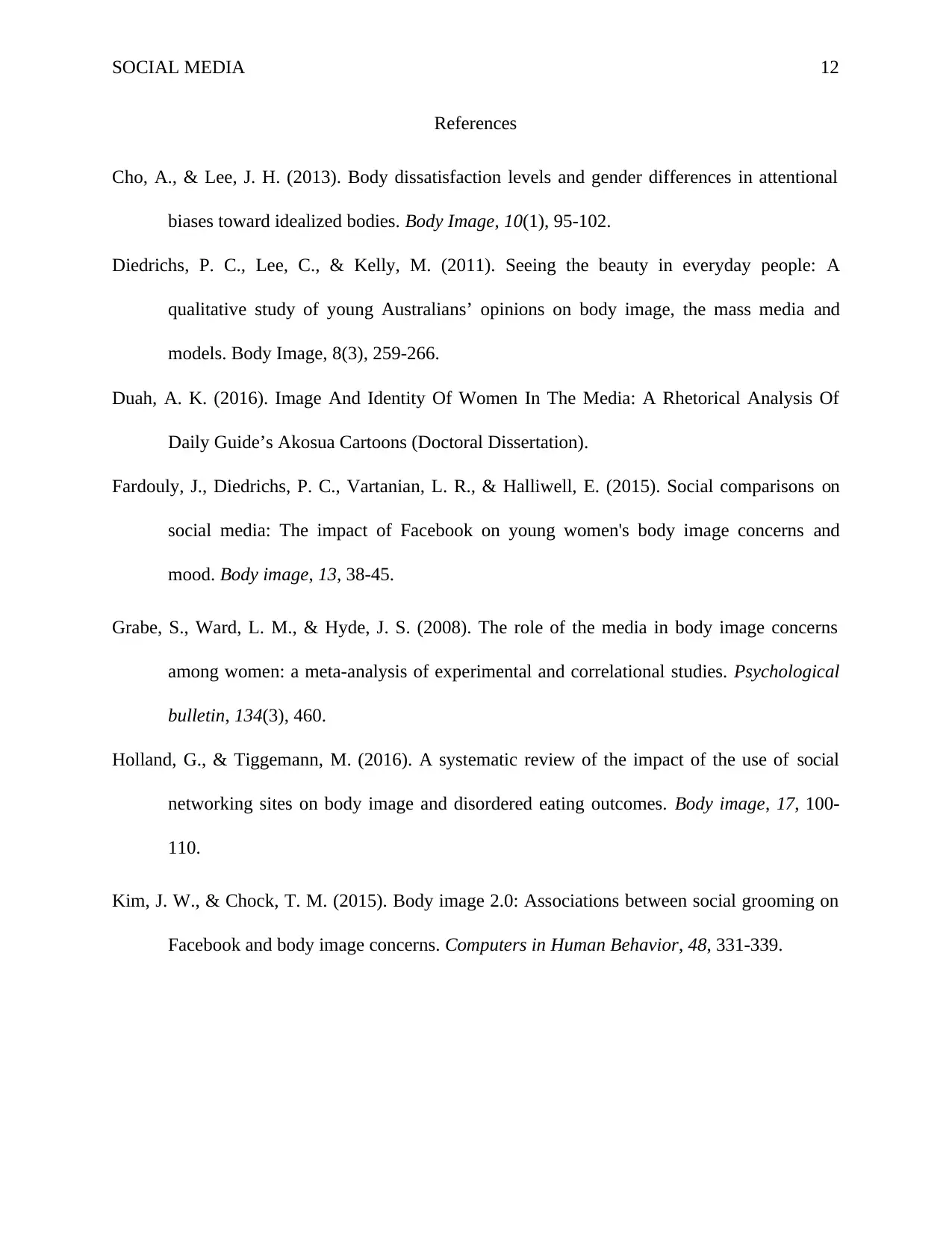
SOCIAL MEDIA 12
References
Cho, A., & Lee, J. H. (2013). Body dissatisfaction levels and gender differences in attentional
biases toward idealized bodies. Body Image, 10(1), 95-102.
Diedrichs, P. C., Lee, C., & Kelly, M. (2011). Seeing the beauty in everyday people: A
qualitative study of young Australians’ opinions on body image, the mass media and
models. Body Image, 8(3), 259-266.
Duah, A. K. (2016). Image And Identity Of Women In The Media: A Rhetorical Analysis Of
Daily Guide’s Akosua Cartoons (Doctoral Dissertation).
Fardouly, J., Diedrichs, P. C., Vartanian, L. R., & Halliwell, E. (2015). Social comparisons on
social media: The impact of Facebook on young women's body image concerns and
mood. Body image, 13, 38-45.
Grabe, S., Ward, L. M., & Hyde, J. S. (2008). The role of the media in body image concerns
among women: a meta-analysis of experimental and correlational studies. Psychological
bulletin, 134(3), 460.
Holland, G., & Tiggemann, M. (2016). A systematic review of the impact of the use of social
networking sites on body image and disordered eating outcomes. Body image, 17, 100-
110.
Kim, J. W., & Chock, T. M. (2015). Body image 2.0: Associations between social grooming on
Facebook and body image concerns. Computers in Human Behavior, 48, 331-339.
References
Cho, A., & Lee, J. H. (2013). Body dissatisfaction levels and gender differences in attentional
biases toward idealized bodies. Body Image, 10(1), 95-102.
Diedrichs, P. C., Lee, C., & Kelly, M. (2011). Seeing the beauty in everyday people: A
qualitative study of young Australians’ opinions on body image, the mass media and
models. Body Image, 8(3), 259-266.
Duah, A. K. (2016). Image And Identity Of Women In The Media: A Rhetorical Analysis Of
Daily Guide’s Akosua Cartoons (Doctoral Dissertation).
Fardouly, J., Diedrichs, P. C., Vartanian, L. R., & Halliwell, E. (2015). Social comparisons on
social media: The impact of Facebook on young women's body image concerns and
mood. Body image, 13, 38-45.
Grabe, S., Ward, L. M., & Hyde, J. S. (2008). The role of the media in body image concerns
among women: a meta-analysis of experimental and correlational studies. Psychological
bulletin, 134(3), 460.
Holland, G., & Tiggemann, M. (2016). A systematic review of the impact of the use of social
networking sites on body image and disordered eating outcomes. Body image, 17, 100-
110.
Kim, J. W., & Chock, T. M. (2015). Body image 2.0: Associations between social grooming on
Facebook and body image concerns. Computers in Human Behavior, 48, 331-339.
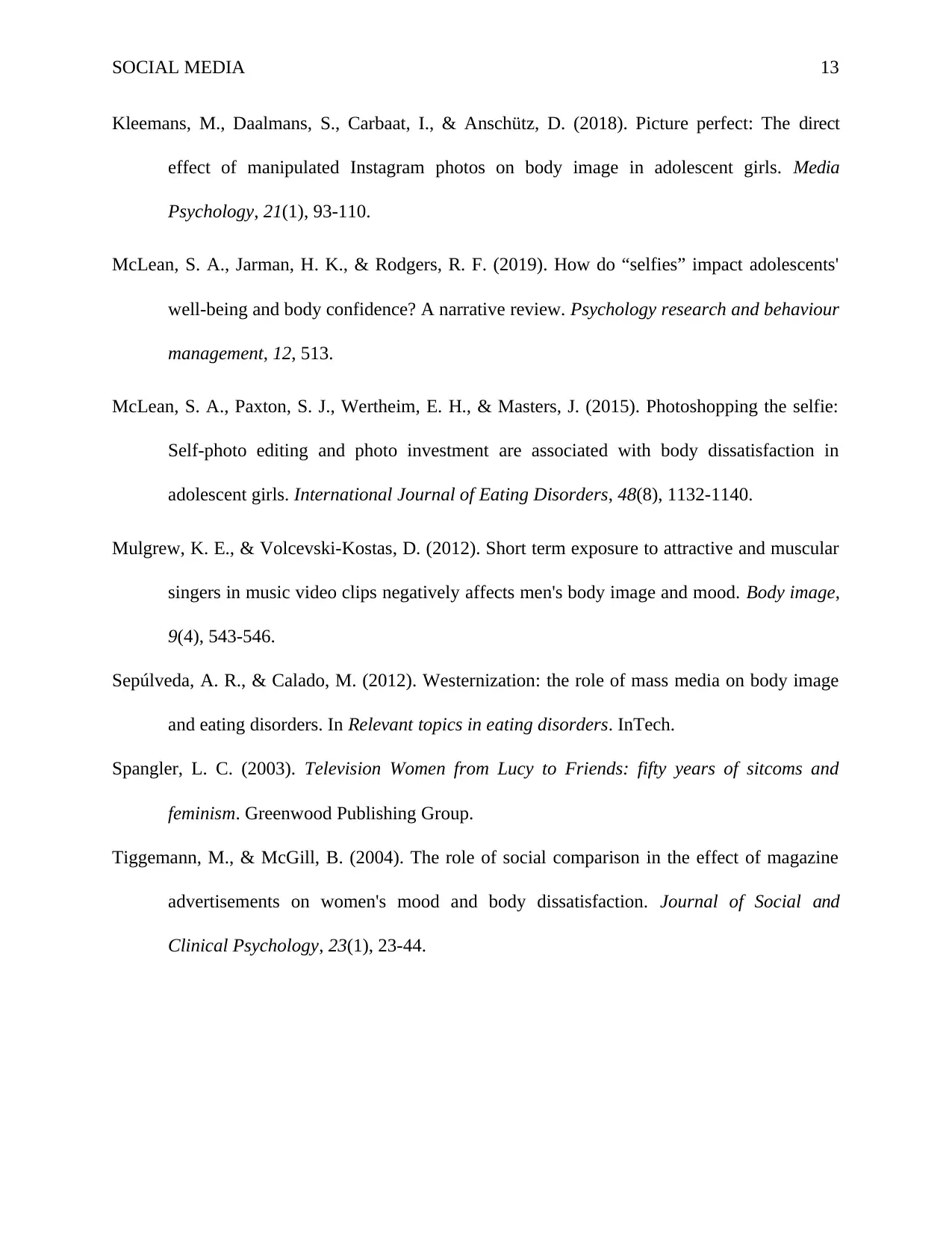
SOCIAL MEDIA 13
Kleemans, M., Daalmans, S., Carbaat, I., & Anschütz, D. (2018). Picture perfect: The direct
effect of manipulated Instagram photos on body image in adolescent girls. Media
Psychology, 21(1), 93-110.
McLean, S. A., Jarman, H. K., & Rodgers, R. F. (2019). How do “selfies” impact adolescents'
well-being and body confidence? A narrative review. Psychology research and behaviour
management, 12, 513.
McLean, S. A., Paxton, S. J., Wertheim, E. H., & Masters, J. (2015). Photoshopping the selfie:
Self-photo editing and photo investment are associated with body dissatisfaction in
adolescent girls. International Journal of Eating Disorders, 48(8), 1132-1140.
Mulgrew, K. E., & Volcevski-Kostas, D. (2012). Short term exposure to attractive and muscular
singers in music video clips negatively affects men's body image and mood. Body image,
9(4), 543-546.
Sepúlveda, A. R., & Calado, M. (2012). Westernization: the role of mass media on body image
and eating disorders. In Relevant topics in eating disorders. InTech.
Spangler, L. C. (2003). Television Women from Lucy to Friends: fifty years of sitcoms and
feminism. Greenwood Publishing Group.
Tiggemann, M., & McGill, B. (2004). The role of social comparison in the effect of magazine
advertisements on women's mood and body dissatisfaction. Journal of Social and
Clinical Psychology, 23(1), 23-44.
Kleemans, M., Daalmans, S., Carbaat, I., & Anschütz, D. (2018). Picture perfect: The direct
effect of manipulated Instagram photos on body image in adolescent girls. Media
Psychology, 21(1), 93-110.
McLean, S. A., Jarman, H. K., & Rodgers, R. F. (2019). How do “selfies” impact adolescents'
well-being and body confidence? A narrative review. Psychology research and behaviour
management, 12, 513.
McLean, S. A., Paxton, S. J., Wertheim, E. H., & Masters, J. (2015). Photoshopping the selfie:
Self-photo editing and photo investment are associated with body dissatisfaction in
adolescent girls. International Journal of Eating Disorders, 48(8), 1132-1140.
Mulgrew, K. E., & Volcevski-Kostas, D. (2012). Short term exposure to attractive and muscular
singers in music video clips negatively affects men's body image and mood. Body image,
9(4), 543-546.
Sepúlveda, A. R., & Calado, M. (2012). Westernization: the role of mass media on body image
and eating disorders. In Relevant topics in eating disorders. InTech.
Spangler, L. C. (2003). Television Women from Lucy to Friends: fifty years of sitcoms and
feminism. Greenwood Publishing Group.
Tiggemann, M., & McGill, B. (2004). The role of social comparison in the effect of magazine
advertisements on women's mood and body dissatisfaction. Journal of Social and
Clinical Psychology, 23(1), 23-44.
1 out of 13
Related Documents
Your All-in-One AI-Powered Toolkit for Academic Success.
+13062052269
info@desklib.com
Available 24*7 on WhatsApp / Email
![[object Object]](/_next/static/media/star-bottom.7253800d.svg)
Unlock your academic potential
© 2024 | Zucol Services PVT LTD | All rights reserved.





